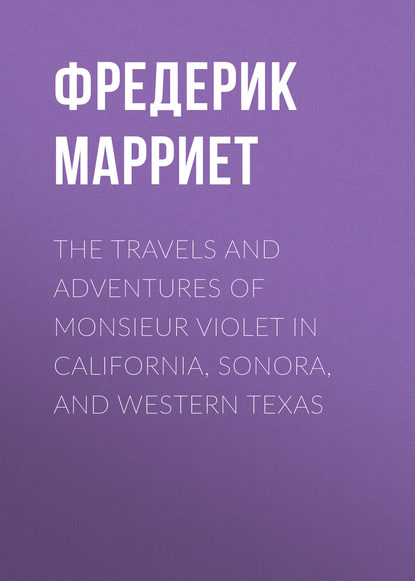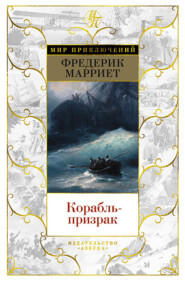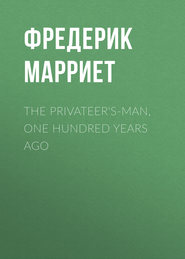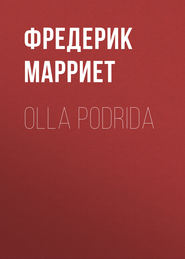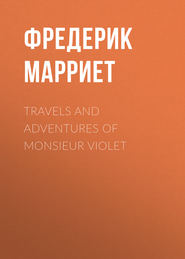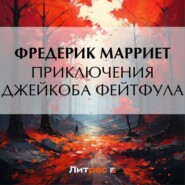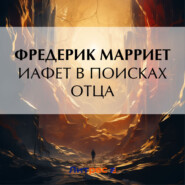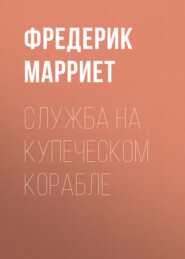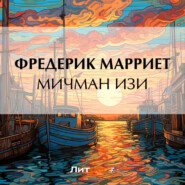По всем вопросам обращайтесь на: info@litportal.ru
(©) 2003-2025.
✖
The Travels and Adventures of Monsieur Violet in California, Sonora, and Western Texas
Автор
Год написания книги
2018
Настройки чтения
Размер шрифта
Высота строк
Поля
"The Pale-faces," he said, "were base dogs, and too great cowards to fight against the Crows. They were less than women, concealing themselves in the lodges of the Shoshones, and lending them their rifles, so that having now plenty of arms and ammunition, that tribe had become strong, and feared by all. But now they would kill the Pale-faces, and they would see what colour was the blood of cowards. When dead, they could not give any more rifles, or powder, to the Shoshones, who would then bury themselves like prairie dogs in their burrows, and never again dare to cross the path of a Crow."
The Prince replied to the chief with scorn. "The Crows," he said, "ought not to speak so loud, lest they should be heard by the Shoshone braves, and lies should never be uttered in open air. What were the Crows before the coming of the white men, on the shores of the Buona Ventura? They had no country of their own, for one part of it had been taken by the Black-feet, and the other by the Arrapahoes and the Shoshones. Then the Crows were like doves hunted by the hawks of the mountains. They would lie concealed in deep fissures of the earth, and never stir but during night, so afraid were they of encountering a Shoshone. But the white men assembled the Shoshones around their settlements, and taught them to remain at peace with their neighbours. They had been so for four years; the Crows had had time to build other wigwams. Why did they act like wolves, biting their benefactors, instead of showing to them their gratitude?"
The Prince, though an old man, had much mettle in him, especially when his blood was up. He had become a Shoshone in all except ferocity; he heartily despised the rascally Crows. As to the chief, he firmly grasped the handle of his tomahawk, so much did he feel the bitter taunts of his captive. Suddenly, a rustling was heard, then the sharp report of a rifle, and one of the Crows, leaping high in the air, fell down a corpse.
"The chief hath spoken too loud," said the Prince; "I hear the step of a Shoshone; the Crows had better run away to the mountains, or their flesh will fatten the dogs of our village."
An expression of rage and deep hatred shot across the features of the chief, but he stood motionless, as did all his men, trying to catch the sounds, to ascertain in which direction they should fly from the danger.
"Fear has turned the Crows into stones," resumed the Prince, "what has become of their light feet? I see the Shoshones."
"The dog of a Pale-face will see them no more," replied the savage, as he buried his tomahawk in the skull of the unfortunate nobleman, who was thus doomed to meet with an inglorious death in a distant land.
The other prisoners, who were bound, could of course offer no resistance. The French savant and two of his guides were butchered in an instant, but before the remainder of the party could be sacrificed, a well-directed volley was poured upon the compact body of the Crows, who rushed immediately to the woods for cover, leaving behind them twenty dead and wounded besides their cruel chief. Then from the thickets behind appeared thirty Shoshones, who immediately gave chase, leaving only one of their men to free the three remaining trappers, and watch over the body of their murdered friend and legislator.
A sharp tiralleur fire from their respective covers was carried on between the Shoshones and Crows for half an hour, in which the Crows lost ten more scalps, and having at length reached a rugged hill full of briars and bushes, they took fairly to their heels, without even attempting to answer the volleys poured after them. The victims were carried to the settlement, and the very day they were consigned to their grave, the Shoshones started for the land of the Crows. The results of the expedition I have mentioned already.
With my father I found the three trappers; two of whom were preparing to start for California, but the third, a young Parisian, who went by the name of Gabriel, preferred remaining with us, and never left me until a long time afterwards, when we parted upon the borders of the Mississippi, when I was forcing my way towards the Atlantic Ocean. He and Roche, when I parted with them, had directed their steps back to the Shoshones; they delighted too much in a life of wild and perilous adventure to leave it so soon, and the Irishman vowed that if he ever returned within the pale of civilization, it would be to Monterey, the only place where, in his long wanderings, he had found a people congenial to his own ideas.
When, in the meeting of a great council, I apprised the tribe of the attack made upon the boat-house by the Umbiquas, and of its results, there was a loud burst of satisfaction. I was made a War-Chief on the spot; and it was determined that a party should immediately proceed to chastise the Umbiquas. My father did not allow me to join it, as there was much to be done in settling the affairs of the Prince, and paying the debts he had contracted at Fort Hall; consequently, I led a clerk's life for two months, writing accounts, &c.–rather a dull occupation, for which I had not the smallest relish. During this time, the expedition against the Umbiquas had been still more successful than that against the Crows, and, in fact, that year was a glorious one for the Shoshones, who will remember it a long while, as a period in which leggings and moccasins were literally sewn with human hair, and in which the blanched and unburied bones of their enemies, scattered on the prairie, scared even the wolves from crossing the Buena Ventura. Indeed, that year was so full of events, that my narration would be too much swelled if I were to enumerate them all.
I had not forgotten the cachette at our landing-place. Every thing was transferred to the boat-house, and the hot days of summer having already begun to render the settlement unpleasant, we removed to the sea-shore, while the major part of the tribe went to hunt in the rolling prairies of the south.
The presents of the good people of Monterey proved to be a great acquisition to my father. There were many books, which he appropriated to himself; being now too aged and infirm to bear the fatigues of Indian life, he had become fond of retirement and reading. As to Gabriel and Roche, we became inseparable, and though in some points we were not on an equality, yet the habit of being constantly together and sharing the same tent united us like brothers.
As my readers will eventually discover, many daring deeds did we perform together, and many pleasant days did we pass, both in the northern cities of Mexico and western prairies of Texas, hunting with the Comanches, and occasionally unmasking some rascally Texans, who, under the paint of an Indian, would commit their murders and depredations upon the remote settlements of their own countrymen.
CHAPTER IX
In the remarks which I am about to make relative to the Shoshones, I may as well observe that the same observations will equally apply to the Comanches, Apaches, and Arrapahoes, as they are but subdivisions and offsets from the original stock–the Shoshones. The Wakoes, who have not yet been mentioned, or even seen, by any other travellers, I shall hereafter describe.
I may as well here observe, that although the Shoshones are always at peace with the Comanches and Apaches, they had for a long while been at war with their descendants, the Arrapahoes, as well as the whole of the Dacotah and Algonquin tribes, as the Crows and Rickarees, Black-feet, Nez-percés, and others.
First, as to their religion–a question highly interesting, and perhaps throwing more light upon their origin than can be collected from tradition, manners, and customs. From my knowledge of the Indians, I believe them, if not more religious, most certainly to be more conscientious, than most Christians. They all believe in one God–Manitou, the author of good, and worship him as such; but believing that human nature is too gross to communicate with the Arbitrator of all things, they pray generally through the intervention of the elements or even of certain animals, in the same manner that the Catholics address themselves to their saints.
The great Manitou is universal among this family, and indeed among all the savage tribes of North America. The interceding spirit alone varies, not with the tribe and nation, but according to individual selection. Children are taught to know "Kishe Manito" (the Almighty), but no more. When the boy is verging upon manhood, he selects his own personal deity, or household god, which is made known to him in his dreams. When he states his intention of seeking the spirit, the parents of the young man order him to fast for three days; then they take away his bow and arrows, and send him far into the woods, the mountains, or the prairies, to wait for the visitation.
An empty stomach and inaction in the lone wilderness are certain to produce reveries and waking dreams. If the young man is thirsty, he thinks of water; of fire or sunshine, if he feels cold; of buffalo or fish, if he is hungry. Sometimes he meets with some reptile, and upon any one of these or other natural causes or productions, his imagination will work, until it becomes wholly engrossed by it.
Thus fire and water, the sun or the moon, a star, a buffalo, or a snake–any one of them, will become the subject of his thoughts, and when he sleeps, he naturally dreams of that object which he has been brooding over.
He then returns home, engraves upon a stone, a piece of wood, or a skin, the form of this "spirit" which his dream has selected for him, wears it constantly on his person, and addresses it, not as a god, but as an intercessor, through which his vows must pass before they can reach the fearful Lord of all things.
Some men among the Indians acquire, by their virtues and the regularity of their lives, the privilege of addressing the Creator without any intervention, and are admitted into the band, headed by the masters of ceremonies and the presidents of the sacred lodges, who receive neophytes and confer dignities. Their rites are secret; none but a member can be admitted. These divines, as of old the priest of Isis and Osiris, are deeply learned; and truly their knowledge of natural history is astonishing. They are well acquainted with astronomy and botany, and keep the records and great transactions of the tribes, employing certain hieroglyphics, which they paint in the sacred lodges, and which none but their caste or order can decipher.
Those few who, in their journey in the wilderness, have "dreamt" of a snake and made it their "spirit," become invariably "Medecines." This reptile, though always harmless in the western countries (except in some parts of the mountains on the Columbia, where the rattlesnake abounds), has ever been looked upon with dread by the Indians, who associate it with the evil spirit. When "Kishe Manito" (the good God) came upon earth, under the form of a buffalo, to alleviate the sufferings of the red man, "kinebec" (the serpent), the spirit of evil gave him battle. This part of their creed alone would almost establish their Brahminic origin.
The "Medecine" inspires the Indian with awe and dread; he is respected, but he has no friends, no squaws, no children. He is the man of dark deeds, he that communes with the spirit of evil; he takes his knowledge from the earth, from the fissures of the rocks, and knows how to combine poisons; he alone fears not "Anim Teki" (thunder). He can cure disease with his spells, and with them he can kill also; his glance is that of the snake, it withers the grass, fascinates birds and beasts, troubles the brain of man, and throws in his heart fear and darkness.
The Shoshone women, as well as the Apache and Arrapahoe, all of whom are of the Shoshone race, are very superior to the squaws of the Eastern Indians. They are more graceful in their forms, and have more personal beauty, I cannot better describe them than by saying that they have more similitude to the Arabian women than any other race. They are very clean in their persons and in their lodges; and all their tribes having both male and female slaves, the Shoshone wife is not broken down by hard labour, as are the squaws of the eastern tribes; to their husbands they are most faithful, and I really believe that any attempt upon their chastity would prove unavailing. They ride as bravely as the men, and are very expert with the bow and arrow, I once saw a very beautiful little Shoshone girl, about ten years old, the daughter of a chief, when her horse was at full speed, kill, with her bow and arrow, in the course of a minute or two, nine out of a flock of wild turkeys which she was in chase of.
Their dress is both tasteful and chaste. It is composed of a loose shirt, with tight sleeves, made of soft and well-prepared doe-skin, almost always dyed blue or red; this shirt is covered from the waist by the toga, which falls four or six inches below the knee, and is made either of swan-down, silk, or woollen stuff; they wear leggings of the same material as the shirt, and cover their pretty little feet with beautifully-worked moccasins; they have also a scarf, of a fine rich texture, and allow their soft and long raven hair to fall luxuriantly over their shoulder, usually ornamented with flowers, but sometimes with jewels of great value; their ankles and wrists are also encircled by bracelets; and indeed to see one of these young and graceful creatures, with her eyes sparkling and her face animated with the exercise of the chase, often recalled to the mind a nymph of Diana, as described by Ovid[10 - The Comanches women very much resemble the common squaws, being short and broad in figure. This arises from the Comanches secluding the women and not permitting them air and exercise.].
Though women participate not in the deeper mysteries of religion, some of them are permitted to consecrate themselves to the divinity, and to make vows of chastity, as the vestals of Paganism or the nuns of the Catholic convents. But there is no seclusion. They dress as men, covered with leather from head to foot, a painting of the sun on their breasts. These women are warriors, but never go out with the parties, remaining always behind to protect the villages. They also live alone, are dreaded, but not loved. The Indian hates anything or any body that usurps power, or oversteps those bounds which appear to him as natural and proper, or who does not fulfil what he considers as their intended destiny.
The fine evenings of summer are devoted, by the young Indian, to courtship. When he has made his choice, he communicates it to his parents, who take the business into their hands. Presents are carried to the door of the fair one's lodge; if they are not accepted, there is an end to the matter, and the swain must look somewhere else; if they are taken in, other presents are returned, as a token of agreement. These generally consist of objects of women's workmanship, such as garters, belts, moccasins, &c.; then follows a meeting of the parents, which terminates by a speech from the girl's father, who mentions his daughter as the "dove," or "lily," or "whisper of the breeze," or any other pretty Indian name which may appertain to her. She has been a good daughter, she will be a dutiful wife, her blood is that of a warrior's; she will bear noble children to her husband, and sing to them his great deeds, &c. The marriage day arrives at last; a meal of roots and fruits is prepared; all are present except the bridegroom, whose arms, saddles, and property are placed behind the fair one. The door of the lodge is open, its threshold lined with flowers; at sunset the young man presents himself, with great gravity of deportment. As soon as he has taken a seat near the girl, the guests begin eating, but in silence; but soon a signal is given by the mothers, each guest rises, preparatory to retiring. At that moment, the two lovers cross their hands, and the husband speaks for the first time, interrogatively:–"Faithful to the lodge, faithful to the father, faithful to his children?" She answers softly: "Faithful, ever faithful, in joy and in sorrow, in life and in death"–"Penir, penir-asha, sartir nú cohta, lebeck nú tanim." It is the last formula,–the ceremony is accomplished. This may seem very simple and ridiculous; to me it appeared almost sublime. Opinions depend upon habits and education.
The husband remains a whole year with his father-in-law, to whom belongs by right the produce of his hunting, both skins and flesh. The year expired, his bondage Is over, and he may if he wishes it, retire with his wife to his own father's, or construct a lodge for his own use. The hunter brings his game to his door, except when a heavy animal; there ends his task; the wife skins and cuts it; she dries the skin and cures the meat. Yet if the husband is a prime hunter, whose time is precious, the woman herself, or her female relations, go out and seek the game where It has been killed. When a man dies, his widow wears mourning during two or four years; the same case happens with the widower, only his duties are not so strict as that of a woman; and it often happens that, after two years, he marries his sister-in-law, if there is any. The Indians think it a natural thing; they say that a woman will have more care of her sister's children than of those of a stranger. Among the better classes of Indians, children are often affianced to each other, even at the age of a few months. These engagements are sacred, and never broken.
The Indians in general have very severe laws against murder, and they are pretty much alike among the tribes; they are divided into two distinct sections–murder committed in the nation and out of the nation.
When a man commits a murder upon his own people, he runs away from his tribe, or delivers himself to justice. In this latter case, the nearest relation of the victim kills him openly, in presence of all the warriors. In the first case, he is not pursued, but his nearest relation is answerable for the deed, and suffers the penalty, if by a given time he has not produced the assassin. The death Is instantaneous, from the blow of a tomahawk. Often the chief will endeavour to make the parties smoke the pipe of peace; if he succeeds, all ends here; If not, a victim must be sacrificed. It is a stern law, which sometimes brings with its execution many great calamities. Vengeance has often become hereditary, from generation to generation; murders have succeeded murders, till one of the two families has deserted the tribe.
It is, no doubt, owing to such circumstances that great families, or communities of savages bearing the same type and speaking the same tongue, have been subdivided into so many distinct tribes. Thus it has been with the Shoshones, whose emigrant families have formed the Comanches, the Apaches, and the Arrapahoes. The Tonquewas have since sprung from the Comanches, the Lepans and the Texas[11 - Formerly there was a considerable tribe of Indians, by the name of Texas, who have all disappeared, from continual warfare.] (now extinct) from the Apaches, and the Navahoes from the Arrapahoes. Among the Nadowessies or Dacotahs, the subdivision has been still greater, the same original tribe having given birth to the Konsas, the Mandans, the Tetons, the Yangtongs, Sassitongs, Ollah-Gallahs, the Siones, the Wallah Wallahs, the Cayuses, the Black-feet, and lastly the Winnebagoes.
The Algonquin species, or family, produced twenty-one different tribes: the Micmacs, Etchemins, Abenakis, Sokokis, Pawtuckets, Pokanokets, Narragansets, Pequods, Mohegans, Lenilenapes, Nanticokes, Powatans, Shawnees, Miamis, Illinois, Chippewas, Ottawas, Menomonies, Sacs, Foxes, and the Kickapoos, which afterwards subdivided again into more than a hundred nations.
But, to return to the laws of murder:–It often happens that the nephew, or brother of the murderer, will offer his life in expiation. Very often these self-sacrifices are accepted, principally among the poorer families, but the devoted is not put to death; he only loses his relationship and connection with his former family; he becomes a kind of slave or bondsman for life in the lodges of the relations of the murdered.
Sometimes, too, the guilty man's life is saved by a singular and very ancient law; it, however, happens but rarely. If the murdered leaves a widow with children, this widow may claim the criminal as her own, and he becomes her husband nominally, that is to say, he must hunt and provide for the subsistence of the family.
When the murderer belongs to a hostile tribe, war is immediately declared; if, on the contrary, he belongs to a friendly nation, the tribe will wait three or four months till the chiefs of that nation come to offer excuses and compensation. When they do this, they bring presents, which they leave at the door of the council lodge, one side of which is occupied by the relations of the victims, the other by the chiefs and warriors of the tribe, and the centre by the ambassadors. One of these opens the ceremony by pronouncing a speech of peace, while another offers the pipe to the relations. If they refuse it, and the great chief of the tribe entertains a particular regard for the other nation, he rises and offers himself to the relations the calumet of conciliation. If refused still, all the children and babes of the murdered one's family are called into the lodge, and the pipe passed a third time in that part of the lodge. Then if a child even two or three months old touches it, the Indians consider the act as a decision of the great Master of Life, the pipe goes round, the presents are carried in, and put at the feet of the plaintiffs. When on the contrary, the calumet passes untouched, the murderer's life alone can satisfy the tribe.
When the chiefs of the tribe of the murderer leave their village to come and offer excuses, they bring with them the claimed victim, who is well armed. If he is held in high estimation, and has been a good warrior and a good man, the chiefs of his tribe are accompanied by a great number of their own warriors, who paint their faces before entering the council lodge; some in black with green spots, some all green (the pipe of peace is always painted green).
The relations of the murdered man stand on one side of the lodge, the warriors of the other tribe opposite to them. In the centre is the chief, who is attended by the bearer of the pipe of peace on one side of him, and the murderer on the other. The chief then makes a speech, and advances with the pipe-bearer and the murderer towards the relatives of the deceased; he entreats them, each man separately, to smoke the pipe which is offered by the pipe-bearer, and when refused, offered to the next of the relatives.
During this time the murderer, who is well armed, stands by the chiefs side, advancing slowly, with his arrow or his carbine pointed, ready to fire at any one of the relations who may attempt to take his life before the pipe has been refused by the whole of them. When such is the case, if the chiefs want peace, and do not care much for the murderer, they allow him to be killed without interference; if, on the contrary, they value him and will not permit his death, they raise the war-whoop, their warriors defend the murderer's life, and the war between the two tribes may be said to have commenced.
Most usually, however, the pipe of peace is accepted, in preference to proceeding to such extremities.
I will now mention the arms and accoutrement of the Shoshone warriors, observing, at the same time, that my remarks refer equally to the Apaches, the Arrapahoes, and the Comanches, except that the great skill of the Shoshones turns the balance in their favour. A Shoshone is always on horseback, firmly sitting upon a small and light saddle of his own manufacture, without any stirrups, which indeed they prefer not to have, the only Indians using them being chiefs and celebrated warriors, who have them as a mark of distinction, the more so that a saddle and stirrups are generally trophies obtained in battle from a conquered enemy.
They have too good a taste to ornament their horses as the Mexicans, the Crows, or the Eastern Indians do; they think that the natural grace and beauty of the animal are such that anything gaudy would break its harmony; the only mark of distinction they put upon their steeds (and the chiefs only can do so) is a rich feather or two, or three quills of the eagle, fixed to the rosette of the bridle, below the left ear; and as a Shoshone treats his horse as a friend, always petting him, cleaning him, never forcing or abusing him, the animal is always in excellent condition, and his proud eyes and majestic bearing present to the beholder the beau ideal of the graceful and the beautiful. The elegant dress and graceful form of the Shoshone cavalier, harmonizes admirably with the wild and haughty appearance of the animal.
The Shoshone allows his well-combed locks to undulate with the wind, only pressed to his head by a small metal coronet, to which he fixes feathers or quills, similar to those put to his horse's rosette. This coronet is made either of gold or silver, and those who cannot afford to use these metals make it with swan-down or deer-skin, well-prepared and elegantly embroidered with porcupine quills; his arms are bare and his wrists encircled with bracelets of the same material as the coronet; his body, from the neck to the waist, is covered with a small, soft deer-skin shirt, fitting him closely without a single wrinkle; from the waist to the knee he wears a many-folded toga, of black, brown, red, or white woollen or silk stuff, which he procures at Monterey or St. Francisco, from the Valparaiso and China traders; his leg from the ankle to the hip is covered by a pair of leggings of deer-skin, dyed red or black with some vegetable acids, and sewed with human hair, which hangs flowing, or in tresses, on the outward side; these leggings are fastened a little above the foot by other metal bracelets, while the foot is encased in an elegantly finished mocassin, often edged with small beautiful round crimson shells, no bigger than a pea, and found among the fossil remains of the country.
Round his waist, and to sustain the toga, he wears a sash, generally made by the squaws out of the slender filaments of the silk-tree, a species of the cotton-wood, which is always covered with long threads, impalpable, though very strong. These are wove together, and richly dyed. I am sure that in Paris or in London, these scarfs, which are from twelve to fifteen feet long, would fetch a large sum among the ladies of the haut ton. I have often had one of them shut up in my hand so that it was scarcely to be perceived that I had anything enclosed in my fist.
Suspended to this scarf, they have the knife on the left side and the tomahawk on the right. The bow and quiver are suspended across their shoulders by bands of swan-down three inches broad, while their long lance, richly carved, and with a bright copper or iron point, is carried horizontally at the side of the horse. Those who possess a carbine have it fixed on the left side by a ring and a hook, the butt nearly close to the sash, and the muzzle protruding a little before the knee.
The younger warriors, who do not possess the carbine, carry in its stead a small bundle of javelins (the jerrid of the Persians), with which they are very expert, for I have often seen them, at a distance of ten feet, bury one more than two feet deep in the flanks of a buffalo. To complete their offensive weapons, they have the lasso, a leather rope fifty feet long, and as thick as a woman's little finger, hanging from the pommel of their saddles; this is a terrible arm, against which there is but little possibility of contending, even if the adversary possess a rifle, for the casting of the lasso is done with the rapidity of thought, and an attempt to turn round and fire would indubitably seal his fate: the only means to escape the fatal noose is to raise the reins of your horse to the top of your head, and hold any thing diagonally from your body, such as the lance, the carbine, or anything except the knife, which you must hold in your right hand, ready for use.
The chances then are: if the lasso falls above your head, it must slip, and then it is a lost throw, but if you are quick enough to pass your knife through the noose, and cut it as it is dragged back, then the advantage becomes yours, or, at least is equally divided, for then you may turn upon your enemy, whose bow, lance, and rifle, for the better management of his lasso, have been left behind, or too firmly tied about him to be disengaged and used in so short a time. He can only oppose you with the knife and tomahawk, and if you choose, you may employ your own lasso; in that case the position is reversed; still the conquest belongs to the most active of the two.
It often happens, that after having cut the lasso and turned upon his foe, an Indian, without diminishing the speed of his horse, will pick up from the ground, where he has dropped it, his rifle or his lance; then, of course, victory is in his hands. I escaped once from being lassoed in that way. I was pursued by a Crow Indian; his first throw failed, so did his second and his third; on the fourth I cut the rope, and wheeling round upon him, I gave chase, and shot him through the body with one of my pistols. The noose at every cast formed such an exact circle, and fell with such precision, the centre above my head, and the circumference reaching from the neck to the tail of my horse, that if I had not thrown away my rifle, lance, bow, and quiver, I should immediately have been dragged to the ground. All the western Indians and Mexicans are admirably expert in handling this deadly weapon.
Before the arrival of the Prince Seravalle, the Shoshones had bucklers, but they soon cast them aside as an incumbrance: the skill which was wasted upon the proper management of this defensive armour being now applied to the improved use of the lance. I doubt much, whether, in the tournaments of the days of chivalry, the gallant knights could show to their ladye-love greater skill than a Shoshone can exhibit when fighting against an Arrapahoe or a Crow[12 - The Crows, our neighbours, who are of the Dacotah race, are also excellent horsemen, most admirably dressed and fond of show, but they cannot be compared to the Shoshones; they have not the same skill, and, moreover, they abuse and change their horses so often that the poor brutes are never accustomed to their masters.].





